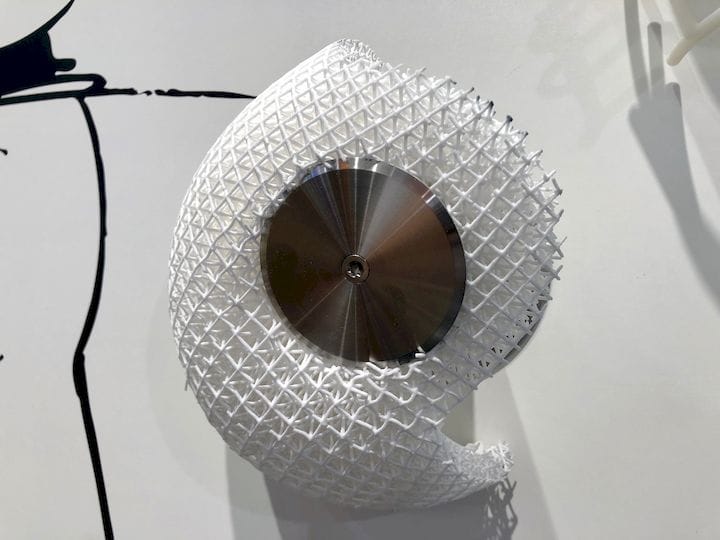![Making breakthroughs in 3D printing [Source: Fabbaloo]](https://fabbaloo.com/wp-content/uploads/2020/05/image-asset_img_5eb0999367c9d.jpg)
I’m reading a piece on Singularity Hub describing “The Next 5 Printing Breakthroughs”, and have my own five thoughts.
The piece lists five breakthroughs they anticipate occurring in the 2019-2024 period. Let’s take a look at them.
3D printing speeds are slated to increase by 50-100X
While it’s not unexpected that some speed increases may occur, I am certain that nothing is “slated” to happen in this regard. Inventions are made or not, but inventors do indeed attempt to overcome the slow durations of 3D printing operations. The trigger for this prediction seems to be recent work at MIT, which indeed offered faster print speeds, but only in a highly restricted manner.
Sustainable, affordable, 3D printed neighborhoods are launching
This is construction 3D printing, which we’ve written a great deal about. I do not see this happening, as the current state of construction 3D printing simply involves the concrete work and ignores all other aspects of building construction. Worse, there seems to be literally zero activity in automating the other aspects of building construction, so I cannot see this truly happening within five years.
Convincing and delicious 3D printed steaks and burgers in fine restaurants on Earth and in space
I’m hard pressed to agree that this is actually 3D printing and not simply kitchen extrusions, as have been done for centuries. Were they to design unusually shaped burgers, perhaps, but they might not fit in a bun. This is more of a social and biotech issue than 3D printing.
Metal 3D printers will overtake plastics
That may have already happened, as this depends on what you are measuring. For example, metal 3D printers are already far more profitable per unit than thermoplastic 3D printers, simply because they are able to be used in high-cost industries, like aerospace. It’s possible that once more companies adopt metal 3D printing and fill their factory lines with the equipment, there could be more metal 3D prints occurring than thermoplastic objects.
“Hey” will be the most frequently used command in design engineering
The idea here is that one might use a Siri-like interface to trigger an instant computer-generated 3D CAD design. That would certainly be wonderful, and it may happen — but only in highly constrained domains. The problem is that a few words spoken simply don’t carry sufficient data to develop a 3D model. Thus one might have to pre-design major aspects of a 3D model and use the few spoken words to tweak it. This is already happening in a few instances where online users can “custom design” simple jewelry items, and it wouldn’t be difficult to see how such systems could be adapted for a voice interface.
I just happen to have five thoughts about things that may happen in 3D printing in the next five years myself:
Factory Integration
For years 3D printers have been designed as standalone machines, where they are operated in a manual manner. This is antithetical for use in today’s factories, which are highly integrated operations, often from end to end. Showing up in such a factory with a standalone machine is essentially ridiculous. My thought is that 3D printers of the next five years will become redesigned to more easily adapt with factory integrations — and then the machine sales will skyrocket.
Resins Take The Desktop
Resin 3D printing offers much better resolution than traditional filament extrusion processes, but up to now we have not seen this type of machine dominate the desktop. There are some reasons why this may change in the next five years. There are increasing numbers of low-cost resin 3D printers on the market, and it’s only a matter of time before more people become familiar with them. Even more importantly, a major desktop 3D printer manufacturer, Prusa Research, is set to release their inexpensive and presumably easy to use SL1 resin 3D printer in only days. If they sell as many SL1s as they have i3s, then the switch is on.
Resin Options Explode
If, as I suspect, resin 3D printing takes off, then we will see a small explosion in the types of resins offered to the public. Resins are quite interesting as you can relatively easily produce ceramics, metals, and other substances with them. If there is a larger market, then manufacturers will follow.
Material Settings Databases
With an explosion of materials, it’s high time that someone organizes a proper method of distributing optimal printer parameters. Matching a 3D printer to a material is a matter of getting the correct parameters, and up to now we’ve depended on either the manufacturer providing them, or simply guessing. A universal database service that distributes them would be enormously welcome. We’ve seen glimpses of this from companies like Ultimaker, which has implemented a closed version of this concept, but what about the rest of the 3D printing universe?
Corporate Consolidation
How many 3D printer companies exist today? Dozens? Hundreds, perhaps? Whatever the number today, it will be far smaller in five years. That’s because some companies will “win”, and some will fail and evaporate. But more importantly the growing usage will attract big investors from other industries who will no doubt buy up some of the successful brands to consolidate the industry. We’ve already seen some of this happening with GE’s purchase of two metal 3D printer manufacturers, and there’s more to come.
Via Singularity Hub











Prusa Research issued some news about their new Original Prusa MINI desktop 3D printer, and it leads to some interesting speculation.